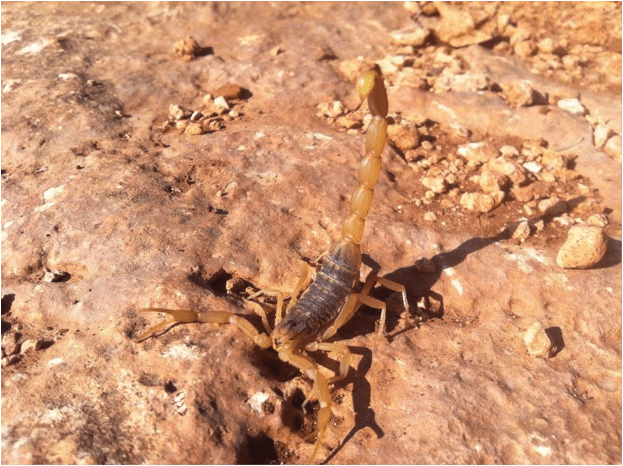
LONG TERM ECOLOGICAL MONITORING (LTER) IN WADI SHITA
As part of the international LTER network, we have established a research site that examines geo-hydro-ecology interactions in Wadi Shita, in the center of the Arava. We are looking at the effect of the geomorphology and topography on the hydrology of the wadi and as a consequence on its ecology. Specifically we are examining acacia health and biodiversity of butterflies, beetles, scorpions and soil fauna.
Geological Analysis:
Based on fieldwork completed in 2014 and 2015, a detailed lithological cross-section of 2.2 meters was created to evaluate soil layers of Wadi Shita, including the red unit.
In October 2014, the Dead Sea and Arava Science Center used a drone to take aerial images of Wadi Shita. The Center examined these images to collect data about the site, including information on the watershed, basin, streams, and topography. The data was analyzed and used to create a digital elevation model and Geographic Information Systems (GIS) maps of the wadi.

Red Unit Analysis
A paleosol is a stratum or soil horizon that was formed as a soil in a past geological period. A paleosol called the “Red Unit” that is found in multiple seasonal water channels (wadi) in the southern Negev region is hypothesized to contribute to the amount of water available to trees throughout the year, thus increasing the number of trees growing in those areas.
Six wadis are currently being studied; three studies include the Red Unit and three do not. In each wadi, the research team analyzes the soil, geology, geomorphology, and density of trees. Soil samples have been collected and analyzed for total organic carbon (TOC) content, calcium carbonate content, and grain size distribution. A geological map of each drainage basin has been prepared using satellite photographs and centralized on a Geographic Information Systems (GIS) map to undergo spatial analysis (Figure 3).

Acacia Monitoring in Wadi Shita:
Monitoring is being performed on samples of species Acacia tortillis, Acacia pachycera, and Acacia raddiana in Wadi Shita using the standardized protocol of אhe Center’s acacia monitoring program. Normalized Difference Vegetation Index (NDVI), dendrometer measurements, and many other parameters measuring physiology and phenology have thus far been used to monitor ninety-eight trees, and will be employed to monitor approximately eighty more. Monitoring occurs four times a year: in December, March, June, and September.
Plant Community Composition:
An analysis of the plant species present in Wadi Shita has been performed by comparing the percentage of each species’ plot cover in four separate plots, each of which is further divided into five sub-plots by proximity to the riverbed and presence of acacias. These five sub-plot categories are defined as outskirts, river bed, river benche, under acacia, and upper wadi. The four plot locations are categorized as: a small wadi in the west of the site coming from the south (Plot 1), a big wadi in the west of the site (Plot 2), a small wadi close to the road coming from the north (Plot 3), and a big wadi close to Road 90 (Plot 4).
The degree of differentiation between sub-plots in terms of species replacement was calculated using Bray-Curtis ß-diversity indices, which were then used to determine the relative differentiation between sub-plots among the four plots. Differences among sub-plots in species richness and percentage of species cover were also compared using the data collected. Differences were then compared among the four plots in species richness and percentage of species cover. Samples were taken in both spring (April 19, 2015) and summer (July 6-7, 2015) for all four plots; seasonal differences in plant cover of thirty-five species were calculated based on this data (Figure 3). The data was then compared to an analysis of the plant species present in the Evrona Nature Reserve.
Insect Monitoring:

Pitfall Traps
Pitfall traps have been used to collect samples of insects in the soil of Wadi Shita since March 2015. Thirty-six dry pitfall traps were set up at the beginning of each month in three different environments: under acacia trees, under shrubs, and in open areas. Afterwards, arthropod activity was monitored over the course of five days.
Soil Mesofauna
The Berlese funnel is an apparatus used to extract living organisms, particularly arthropods, from soil. Experiments are currently being conducted in Wadi Shita to develop a technique to adapt the Berlese funnels to a desert habitat in order to monitor mesofauna composition.
Bees
In April 2015, bees were collected from four separate plots in Wadi Shita (84 bees collected) and three separate plots in Wadi Ramon (16 bees collected) for comparison between the sites. The four plot locations in Wadi Shita were categorized as follows: small wadi west of the site coming from the south (Plot 1), large wadi on west side (Plot 2), small wadi near northern road (Plot 3), and large wadi by Road 90 (Plot 4). The samples were taken from sixteen different plant species during both evening and morning hours, representing fifteen genera of bees. In total, 101 samples were collected.
Climate Change Experiments:
Extreme events, such as droughts and floods, are the main indicators of climate change in the desert. In this simulation study, the frequency of flood activity is altered without changing the magnitude by watering small plots. The project examines frequency and magnitude of the simulated floods’ effect on soil properties, plant diversity, and insect biodiversity.
Yoram Hofman, Inbal Pipman, Nitzan Segev
